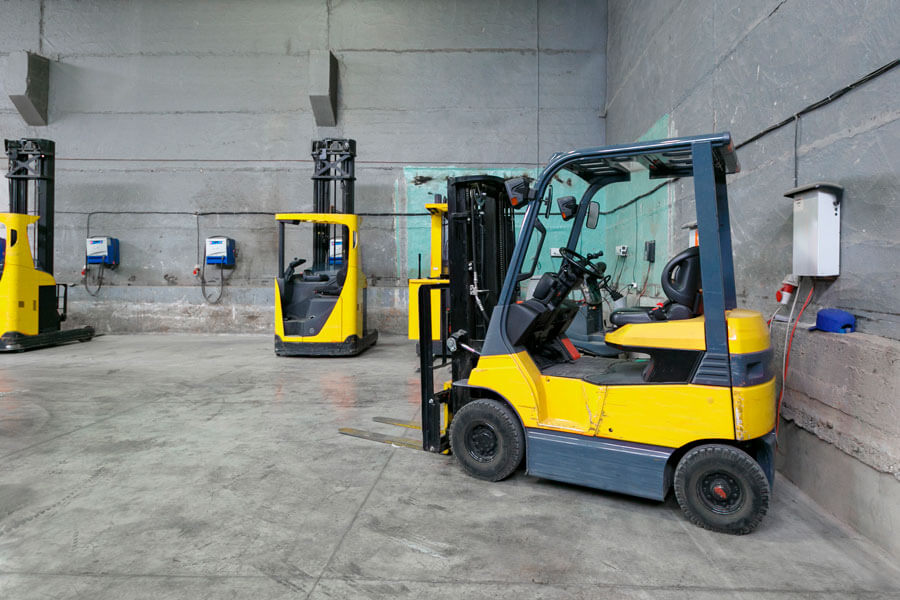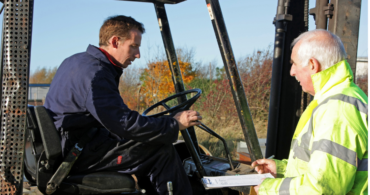Forklift battery charging can be intimidating, even to seasoned professionals. However, as long as you take safety precautions and follow the appropriate steps, the right method of forklift charging can maximize the life and performance of your batteries.
The batteries that power electric forklifts are large, heavy and represent a significant investment. So, anyone working on one needs to practice proper care and maintenance. Doing otherwise could damage the battery, which will shorten its life and possibly void the warranty.
Here are the forklift battery charging instructions to help a battery power forklift run to its full potential. Also, please remember that if you have any issues or concerns about how to charge a forklift battery, you can always reach out—(888) 316-2459—to a Texas Motive Solutions expert.
What step should you take before charging a forklift battery?
When charging a battery on a forklift start by moving the forklift to the charging area. According to OSHA (the Occupational Safety and Health Administration), forklift battery charging stations require several safety features: ventilation to remove hydrogen vapors (if hydrogen concentration is significant enough to possibly ignite due to a spark), fire protection or a fire extinguisher, a safety shower, an eyewash station, no smoking signs and acid neutralization materials. For more forklift safety information, including forklift batteries and battery charging info, check the OSHA website.
Once you park the forklift, you’re ready to charge.
How to charge a forklift battery
- Apply the forklift’s parking brake.
- Turn the key to the off position.
- Raise the seat to expose the battery.
- Put on the proper personal protective equipment (PPE), such as safety glasses, a face shield, gloves and an apron.
- Select a charger that matches the output voltage and amp hours (ah) capacity of the forklift battery.
- Check the charger cables to make sure they are in proper working condition. Look for signs of burning, damage or cracks. If you find any loose cables or damage to the battery, contact a forklift battery repair service like Texas Motive Solutions.
- Disconnect the battery from the forklift.
- If you need to remove the battery from the forklift, don’t try to lift it manually.
- Transportation of batteries should only be performed by a trained and experienced professional.
- Always use proper equipment, like a pallet jack equipped with a transfer carriage.
- After removing the battery from the forklift and before transport, make sure it is secure to avoid spillage.
- Connect the charger to the battery.
- Be careful not to plug the charger into the forklift terminal.
- Doing so will not charge the battery and could damage the forklift, charger or both.
- Never charge a forklift battery if it is too hot or too cold.
- Doublecheck the charger to make sure it indicates that charging is in progress.
- ALWAYS stop the charger before disconnecting the battery, especially If you need to stop the activity before charging is complete. Doing otherwise could cause a dangerous situation where electricity arcs between the battery and the charger cables.
- If you need to add water to a flooded lead-acid battery, do it after charging is complete and the battery has cooled.
- Never water a flooded lead-acid battery before charging.
- Keep a log of every time you water the flooded lead-acid battery.
How to charge a dead forklift battery
Don’t.
At least, when it comes to a flooded lead-acid battery, you never want to let it run down to 0% charge.
As flooded lead-acid forklift batteries discharge, the lead material on the plates reacts with sulfate in the electrolyte fluid. This interaction creates lead sulfate crystals that form on the plates. When these crystals build up, it creates an electrically resistant surface that depletes the battery’s ability to charge and may make it unusable.
The best way to avoid the buildup of lead sulfate crystals is to follow proper charging protocols.
When you see that a flooded lead-acid forklift battery is nearing a 20% charge (known as the “red zone”), that is the best time to start the charge cycle. Charging a forklift battery between 20% and 30% provides the ideal balance of battery life, performance and downtime.
Be sure to charge a flooded lead-acid battery fully before removing it from the charger. Batteries have a limited number of charges, around 1,500 (a five-year lifespan). A lead-acid battery can’t distinguish between half and full charges. So, every charge, even one from 80% to 100%, uses one of those 1,500 charges.
How long does it take to charge a forklift battery?
Well, that depends on the type of battery and charger you use for your forklifts.
For a flooded lead-acid battery, you want to let the battery run down to the red zone and then let it charge to 100%. It takes about eight hours to charge a flooded lead-acid battery fully. To get the most out of your forklift battery utilization, try to follow the “8-8-8 Rule,” also known as conventional charging:
- 8 hours in operation.
- 8 hours on the charger.
- 8 hours to cool down.
There are flooded lead-acid batteries designed for opportunity and rapid, which requires charging during all scheduled breaks over 15 minutes. The difference between opportunity and rapid chargers is how fast the battery charges in these short-charge intervals.
The basic rule of thumb for opportunity and rapid chargers is “if the battery is not in use for 15 minutes or more, take it to the charger and connect.” It is VERY important that opportunity and rapid charging is only done with batteries and chargers specifically designed for this type of use. Trying to “rapid charge” a conventional battery on a conventional charger will damage the battery and severely shorten its life.
For a thin plate pure lead (TPPL) battery, you want to charge every chance you get. This approach is known as “opportunity charging.” Opportunity charging allows a forklift operator to charge their forklift battery whenever convenient, such as during a lunch break. TPPL batteries run best and have a longer life span when kept at the highest charge possible. A good rule for TPPL batteries is “if the truck sits longer than 15 minutes, plug it in.” You only need to fully charge a TPPL battery once a week. TPPL batteries require no watering and have a very low internal resistance, allowing for fast and frequent charging without overheating, like flooded lead-acid batteries tend to do. This makes them a very popular new technology.
Finally, lithium-ion batteries have extremely fast recharge capabilities. This “rapid charging” utilizes a high-frequency battery charger. Most high-quality lithium-ion batteries can go from 0% to 100% charged in about an hour. We say “high-quality” because lithium-ion batteries can be volatile. So, you only want to purchase UL-approved lithium-ion batteries of high-grade lithium chemistry (nickel manganese cobalt) from a well-known manufacturer.
Remember, regardless of battery type, always turn the charger off before disconnecting the battery. Hopefully, this guide has cleared up all of your questions about how to charge forklift battery. If you’ve noticed that your forklift batteries are losing their charges earlier than they should or if there is any other problem with your batteries, the Texas Motive Solutions forklift battery repair team is always here to help. Please call us at (888) 316-2459 or fill out a form to learn about our services and discover everything we can do for you.


